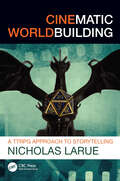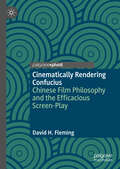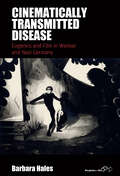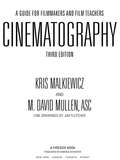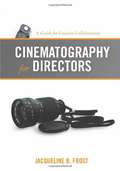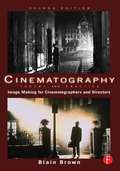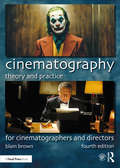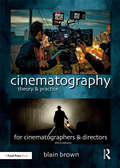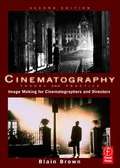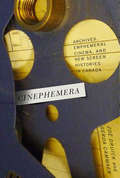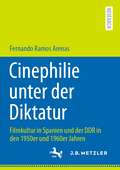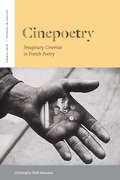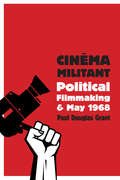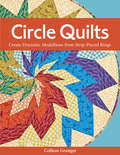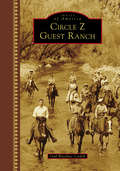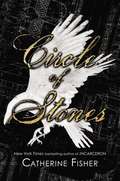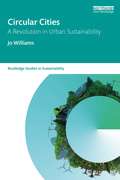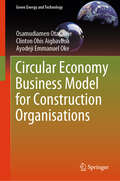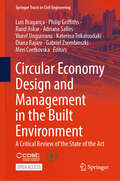- Table View
- List View
Cinematic Worldbuilding: A TTRPG Approach to Storytelling
by Nicholas LaRueEverybody has a story in them. Some people lack the language and the tools to tell that story effectively. As an avid tabletop role-playing game player, I’m amazed at people’s ability to tell stories on the spot. Both the players and the game masters are creating worlds in their minds and playing out the events, using improv, in real-time. Being an author and screenwriter, I know how difficult it is to create consistent and well-constructed characters, themes, and conflicts. I believe that storytellers looking to level up in the classroom, their hobby, or career could learn a lot from games like Dungeons & Dragons, Pathfinder, and others. This book seeks to give people the tools and language to create and master their worlds and characters, using TTRPG mechanics and rulesets as foundational elements. This book will contain insights and interviews from some of today’s most respected game masters, players, actual play actors, and we’ll also hear from some of the people behind the scenes responsible for creating these games, and how they view worldbuilding and storytelling for their audiences.
Cinematically Rendering Confucius: Chinese Film Philosophy and the Efficacious Screen-Play
by David H. FlemingCinematically Rendering Confucius marks the first book-length enquiry into China’s first two big screen treatments of arguably the best-known and most influential thinker in world history: Confucius. By interweaving methods drawn from Film Studies, Comparative Philosophy, and Media Archaeology in response to broader calls to deepen and thicken the scope and purview of film philosophical enquiry, this trailblazing book grounds Fei Mu’s 1940 patriotic art film Kǒng Fūzǐ and Hu Mei's 2010 “Huallywood” blockbuster Kǒngzǐ as pre- and postsocialist examples of Chinese politico-philosophical filmmaking that straddle the PRC’s revolutionary Marxist socio-political experiment. After exploring the geopolitics surrounding why Confucius has been historically included and excluded from the European classification of “philosopher” and addressing the difficulties that entering into “Chinese Thought” presents to non-natives, the book’s first half undertakes a deep dive into the history of (re)mediating the Confucian image-imagination. Arguing that Confucius might be a form of film philosopher avant la lettre, we thereafter explore repetitions and differences surrounding the ever-changing treatment and representation of Confucius on-screen—concluding with a look at the latest AI-infused theory-film When Marx Met Confucius (2023).
Cinematically Transmitted Disease: Eugenics and Film in Weimar and Nazi Germany (Film Europa #28)
by Barbara HalesPropaganda played an essential role in influencing the attitudes and policies of German National Socialism on racial purity and euthanasia, but little has been said on the impact of medical hygiene films. Cinematically Transmitted Disease explores these films for the first time, from their inception during the Weimar era and throughout the years to come. In this innovative volume, author Barbara Hales demonstrates how medical films as well as feature films were circulated among the German people to embed and enforce notions of scientific legitimacy for racial superiority and genetically spread “incurable” diseases, creating and maintaining an instrumental fear of degradation in the German national population.
Cinematography
by Kris Malkiewicz M. David MullenThe Essential Guide to the Cameraman's Craft Since its initial publication in 1973, Cinematography has become the guidebook for filmmakers. Based on their combined fifty years in the film and television industry, authors Kris Malkiewicz and M. David Mullen lay clear and concise groundwork for basic film techniques, focusing squarely on the cameraman's craft. Readers will then learn step-by-step how to master more advanced techniques in postproduction, digital editing, and overall film production. This completely revised third edition, with more than 200 new illustrations, will provide a detailed look at: How expert camera operation can produce consistent, high-quality results How to choose film stocks for the appearance and style of the finished film How to measure light in studio and location shooting for the desired appearance How to coordinate visual and audio elements to produce high-quality sound tracks Whether the final product is a major motion picture, an independent film, or simply a home video, Cinematography can help any filmmaker translate his or her vision into a quality film.
Cinematography and Lighting for Television: A Contemporary Approach
by Tim PalmerDrawing from author Tim Palmer's 30 years of experience working as a cinematographer for award-winning drama series including Killing Eve, Bad Sisters, and Line of Duty, this book is the go-to guide on how to light just about any scene a cinematographer may face when shooting a TV show.Focusing on lighting scenarios suitable for the small screen, the book is thematically organised into night and day, exteriors and interiors, and special situations including magic hour, candlelight and firelight, moonlight, torchlight, vehicle interiors, and green/blue screen, as well as providing examples from within the studio for each of these settings. Using the latest technology and developments in the practice, Palmer illustrates how cinematographers can effectively use lighting within a variety of situations. Palmer works through each example by illustrating and describing the setup with the corresponding finished film frames to show the final effect of the lighting achieved so cinematographers can easily apply and translate it to their own work.Including practical advice for working in the industry and tips for low-budget and student settings, this is an accessible and creative guide to producing visually compelling footage that translates the script to the screen. Ideal for the professional cinematographer and advanced students of cinematography looking to develop their skills.
Cinematography for Directors: A Guide for Creative Collaboration
by Jacqueline B. FrostThe essential handbook for directors and aspiring filmmakers who want to get the best visuals for their films while establishing a collaborative relationship with their cinematographer. This is the only book that focuses exclusively on the relationship between the director and cinematographer.
Cinematography, Theory and Practice: Image Making for Cinematographers and Directors (Second Edition)
by Blain BrownThere's more to being a DP than holding a light meter! With this book as your guide, you are on your way to learning not only about the equipment and technology, but also about the concepts and thought processes that will enable you to shoot professionally, efficiently, and with artistic mastery. A leading book in the field, Cinematography has been translated into many languages and is a staple at the world's top film schools. Lavishly produced and illustrated, it covers the entire range of the profession. The book is not just a comprehensive guide to current professional practice; it goes beyond to explain the theory behind the practice, so you understand how the rules came about and when it's appropriate to break them. In addition, directors will benefit from the book's focus on the body of knowledge they should share with their Director of Photography. Cinematography presents the basics and beyond, employing clear explanations of standard practice together with substantial illustrations and diagrams to reveal the real world of film production. Recognizing that professionals know when to break the rules and when to abide by them, this book discusses many examples of fresh ideas and experiments in cinematography. Covering the most up-to-date information on the film/digital interface, new formats, the latest cranes and camera support and other equipment, it also illustrates the classic tried and true methods. New! A DVD and website features hours of video footage, offering key instruction in topics such as camera basics and essentials, lighting, shooting methods, and much more. Topics include: Concepts of filmmaking, Language of the lens, Cinematic continuity, Lighting for film, digital, and HD, Exposure HD cinematography and shooting, Shooting in HD, Image control and filters, Bleach bypass processes, Lighting as storytelling, Shooting special effects, Set procedures and other issues. The DVD files are also available at http://www. taylorandfrancis. com/cw/brown-9780240812090/.
Cinematography: For Cinematographers and Directors
by Blain BrownThis book covers both the artistry and craftsmanship of cinematography and visual storytelling. Few art forms are as tied to their tools and technology as is cinematography. Take your mastery of these new tools, techniques, and roles to the next level with this cutting-edge roadmap from author and filmmaker Blain Brown. This 4th edition has been thoroughly updated throughout to include detailed information on the latest lighting and camera equipment, as well as expanded and updated discussion on the following areas: shooting on a budget, color spaces with emphasis on the new UHD standards, the decision-making process in choosing what lights and equipment to use, considerations concerning power issues, safety and what electrical supply is needed for various types of lights, an examination of the cinematographer’s role in preproduction, and much more. Topics Include: • Visual storytelling • Continuity and coverage • Cameras and digital sensors • The tools and basics of film lighting • Methods of shooting a scene • Continuity and coverage • Exposure • Color • Understanding digital images • Using linear, gamma, and log video • Image control and grading on the set • Data management and the DIT • Optics and focus • Camera movement • Set operations • Green screen, high speed, and other topics.Whether you are a student of filmmaking, someone just breaking into the business, working in the field and looking to move up the ladder, or an experienced filmmaker updating your knowledge of tools and techniques, this book provides both the artistic background of visual language and also the craft of shooting for continuity, lighting tools and methods, and the technical side of capturing images on digital or on film. The companion website (www.routledge.com/cw/brown) features additional material, including lighting demonstrations, basic methods of lighting, methods of shooting a scene, using diffusion, and other topics.
Cinematography: Image Making for Cinematographers and Directors
by Blain BrownThe world of cinematography has changed more in the last few years than it has since it has in 1929, when sound recording was introduced. New technology, new tools and new methods have revolutionized the art and craft of telling stories visually. While some aspects of visual language, lighting and color are eternal, shooting methods, workflow and cameras have changed radically. Even experienced film artists have a need to update and review new methods and equipment. These change affect not only the director of photography but also the director, the camera assistants, gaffers, and digital imaging technicians. Cinematography: Theory and Practice covers both the artistry and craftsmanship of cinematography and visual storytelling. Few art forms are as tied to their tools and technology as is cinematography. Take your mastery of these new tools, techniques, and roles to the next level with this cutting-edge roadmap from author and filmmaker Blain Brown. Whether you are a student of filmmaking, just breaking into the business, currently working in the industry and looking to move up to the next level, or an experienced professional who wants to update their knowledge of tools and techniques, this book provides both a basic introduction to these issues as well as more advanced and in-depth coverage of the subject. The companion website features additional material, including lighting demonstrations, basic methods of lighting, using diffusion and other topics. Topics Include: Visual language Visual storytelling Continuity and coverage Cameras and digital sensors Exposure techniques for film and video Color in-depth Understanding digital images Waveform monitors, vectorscopes, and test charts Using linear, gamma, and log encoded video Image control and grading on the set The tools and basics of film lighting ASC-CDL, ACES and other new methods Optics and focus Camera movement Set operations Green screen, high speed and other topics
Cinematography: Theory and Practice
by Blain BrownThere's more to being a DP than holdng a light meter! With this book as your guide, you are on your way to learning not only about the equipment and technology, but also about the concepts and thought processes that will enable you to shoot professionally, efficiently, and with artistic mastery. A leading book in the field, Cinematography has been translated into many languages and is a staple at the world's top film schools. Lavishly produced and illustrated, it covers the entire range of the profession. The book is not just a comprehensive guide to current professional practice; it goes beyond to explain the theory behind the practice, so you understand how the rules came about and when it's appropriate to break them. In addition, directors will benefit from the book's focus on the body of knowledge they should share with their Director of Photography.Cinematography presents the basics and beyond, employing clear explanations of standard practice together with substantial illustrations and diagrams to reveal the real world of film production. Recognizing that professionals know when to break the rules and when to abide by them, this book discusses many examples of fresh ideas and experiments in cinematography. Covering the most up-to-date information on the film/digital interface, new formats, the latest cranes and camera support and other equipment, it also illustrates the classic tried and true methods.
Cinephemera
by Zoë Druick Gerda CammaerWhat do digital platforms mean for cinema studies in Canada? In an era when digital media are proliferating and thousands upon thousands of clips are available online, it seems counter-intuitive to say that audio-visual history is quickly disappearing. But the two processes are actually happening in tandem. Adopting a media-archaeological approach to the history of cinema, contributors to Cinephemera cover a wide range of pressing issues relating to Canadian cinema's ephemerality, including neglected or overlooked histories, the work of found footage filmmakers, questions about access and copyright, and practices of film archiving. Spurred by rapid changes to technologies of production, viewing, and preservation, this collection showcases both leading and emerging scholars grappling with the shifting meaning of cinema as an object of study. Film historians are put in conversation with experimental filmmakers and archivists to provide renewed energy for cinema studies by highlighting common interests around the materiality and circulation of films, videos, and other old media. Considering a wide range of cases from the earliest days of silent film production to the most recent initiatives in preservation, Cinephemera exposes the richness of moving image production in Canada outside the genres of feature length narrative fiction and documentary - a history that is at risk of being lost just as it is appearing. Contributors include Andrew Burke (Winnipeg), Jason Crawford (Champlain), Liz Czach (Alberta), Seth Feldman (York), Monika Kin Gagnon (Concordia), André Habib (Montreal), Randolph Jordan (SFU), Peter Lester (Brock), Scott Mackenzie (Queen's); Louis Pelletier (Montreal), Katherine Quanz (WLU), Micky Story (New College), Charles Tepperman (Calgary), Jennifer VanderBurgh (Saint Mary's), William C. Wees (McGill), Jerry White (Dalhousie), and Christine York (Concordia).
Cinephemera: Archives, Ephemeral Cinema, and New Screen Histories in Canada
by Zoë Druick Gerda CammaerWhat do digital platforms mean for cinema studies in Canada? In an era when digital media are proliferating and thousands upon thousands of clips are available online, it seems counter-intuitive to say that audio-visual history is quickly disappearing. But the two processes are actually happening in tandem. Adopting a media-archaeological approach to the history of cinema, contributors to Cinephemera cover a wide range of pressing issues relating to Canadian cinema's ephemerality, including neglected or overlooked histories, the work of found footage filmmakers, questions about access and copyright, and practices of film archiving. Spurred by rapid changes to technologies of production, viewing, and preservation, this collection showcases both leading and emerging scholars grappling with the shifting meaning of cinema as an object of study. Film historians are put in conversation with experimental filmmakers and archivists to provide renewed energy for cinema studies by highlighting common interests around the materiality and circulation of films, videos, and other old media. Considering a wide range of cases from the earliest days of silent film production to the most recent initiatives in preservation, Cinephemera exposes the richness of moving image production in Canada outside the genres of feature length narrative fiction and documentary - a history that is at risk of being lost just as it is appearing. Contributors include Andrew Burke (Winnipeg), Jason Crawford (Champlain), Liz Czach (Alberta), Seth Feldman (York), Monika Kin Gagnon (Concordia), André Habib (Montreal), Randolph Jordan (SFU), Peter Lester (Brock), Scott Mackenzie (Queen's); Louis Pelletier (Montreal), Katherine Quanz (WLU), Micky Story (New College), Charles Tepperman (Calgary), Jennifer VanderBurgh (Saint Mary's), William C. Wees (McGill), Jerry White (Dalhousie), and Christine York (Concordia).
Cinephilie unter der Diktatur: Filmkultur in Spanien und der DDR in den 1950er und 1960er Jahren
by Fernando Ramos ArenasDiese Studie analysiert aus komparativer Perspektive die Filmkultur in Spanien und der DDR zur Zeit der Neuen Kinos. Fern von klassischen westeuropäischen Zentren nahmen in diesen Jahren Filmenthusiasten (Filmklubmitglieder, Filmkritiker und -studenten, Archiv- und Festivalbesucher...) an einer Erneuerungswelle transnationalen Charakters teil, die eine Reaktion auf die traditionellen, oft mit staatlichen Initiativen verwobenen Filmlandschaften postulierte. Trotz politischer Einschränkungen wurde die Filmkultur in beiden Diktaturen zu einem lebendigen Feld, das intensiv in die Vergangenheit schaute, sich international neu verortete und über Kino mit einer bis dahin nicht gekannten Intensität debattierte. Dieses Buch rekonstruiert diese Geschichte auf der Grundlage von Archivmaterialien unterschiedlicher Provenienz, Interviews mit Zeitzeugen sowie der Analyse der wichtigsten Publikationen der Zeit und bietet somit einen innovativen Beitrag, der unseren Blick auf die Geschichte der europäischen Filmkultur grundlegend erweitern soll.
Cinepoetry: Imaginary Cinemas in French Poetry (Verbal Arts: Studies in Poetics)
by Christophe Wall-RomanaCinepoetry analyzes how French poets have remapped poetry through the lens of cinema for more than a century. In showing how poets have drawn on mass culture, technology, and material images to incorporate the idea, technique, and experience of cinema into writing, Wall-Romana documents the long history of cross-media concepts and practices often thought to emerge with the digital.In showing the cinematic consciousness of Mallarmé and Breton and calling for a reappraisal of the influential poetry theory of the early filmmaker Jean Epstein, Cinepoetry reevaluates the bases of literary modernism. The book also explores the crucial link between trauma and trans-medium experiments in the wake of two world wars and highlights the marginal identity of cinepoets who were often Jewish, gay, foreign-born, or on the margins.What results is a broad rethinking of the relationship between film and literature. The episteme of cinema, the book demonstates, reached the very core of its supposedly highbrow rival, while at the same time modern poetry cultivated the technocultural savvy that is found today in slams, e-poetry, and poetic-digital hybrids.
Cinesthesia: Museum Cinema and the Curated Screen (Kino-agora Ser.)
by Garrett StewartIn this profusely illustrated meditation on the phenomenon of "museum cinema," the screening of films in art museums, Garrett Stewart explores the aesthetic and formal issues raised by the proliferation of screens and films in museums in the digital era. Taking up dozens of screen artifacts over the last six decades, from 16mm loops to CCTV montage, Cinesthesia investigates in exemplary depth an array of landmark innovations from the 1960s down through the latest conceptualist exhibitions. Probing and comparative at once, it is the first study to place individual works under close formal and cultural analysis, and in steady dialogue with each other, not just as intrinsic experimental ventures but as medial challenges: challenges both to their parent forms and genres (theatrical film, broadcast TV) and to the contemplative aesthetic of museum looking. The kinetics of watching are found in this way, repeatedly and often ironically, to reroute or even derange – and ultimately to reform – the apprehending gaze. Cinesthesia includes 44 full-page colour illustrations by nearly 30 artists, including Christian Marclay, Tacita Dean, John Akomfrah, Rodney Graham, Eve Sussman and Matej Kren. "How is it – by what aesthetic criteria – that we, in ticketed public space, go to see film without going to the movies? What happens, that is, when screening times are replaced by the intermittent and elective time of transient viewing in sectored zones of a gallery layout? What new (audio-) visual parameters, in other words, are set in place when moving-image work finds itself welcomed into the environs of the proverbial 'fine' (or plastic) arts?" — Garrett Stewart
Cinesthesia: Museum Cinema and the Curated Screen (Kino-agora Ser.)
by Garrett StewartIn this profusely illustrated meditation on the phenomenon of "museum cinema," the screening of films in art museums, Garrett Stewart explores the aesthetic and formal issues raised by the proliferation of screens and films in museums in the digital era. Taking up dozens of screen artifacts over the last six decades, from 16mm loops to CCTV montage, Cinesthesia investigates in exemplary depth an array of landmark innovations from the 1960s down through the latest conceptualist exhibitions. Probing and comparative at once, it is the first study to place individual works under close formal and cultural analysis, and in steady dialogue with each other, not just as intrinsic experimental ventures but as medial challenges: challenges both to their parent forms and genres (theatrical film, broadcast TV) and to the contemplative aesthetic of museum looking. The kinetics of watching are found in this way, repeatedly and often ironically, to reroute or even derange – and ultimately to reform – the apprehending gaze. Cinesthesia includes 44 full-page colour illustrations by nearly 30 artists, including Christian Marclay, Tacita Dean, John Akomfrah, Rodney Graham, Eve Sussman and Matej Kren. "How is it – by what aesthetic criteria – that we, in ticketed public space, go to see film without going to the movies? What happens, that is, when screening times are replaced by the intermittent and elective time of transient viewing in sectored zones of a gallery layout? What new (audio-) visual parameters, in other words, are set in place when moving-image work finds itself welcomed into the environs of the proverbial 'fine' (or plastic) arts?" — Garrett Stewart
Cinécdoque
by Luis ReséndizCinécdoque es el libro que los cinéfilos necesitaban para repensar el cine comercial, reflexionar sobre sus cambios y llevar más allá de la pantalla las conquistas del séptimo arte. Con prólogo de Fernanda Solórzano. «Los textos de Cinécdoque aportan una mirada profunda a películas y fenómenos que otros, desde la pereza, consideran ligeros. Más importante, su autor es un defensor acérrimo del ensayo bien meditado. Este libro da prueba de ello y, al hacerlo, también declara: la mejor crítica cinematográfica -la única que permanece- es la que se disfruta leer.» Fernanda Solórzano, en el prólogo «Un análisis detallado sobre el blockbuster, así como una amplia disección de los elementos frecuentemente desapercibidos en su contexto [...] Si la cultura pop nutre a sociedades enteras, ¿por qué negar que también forma parte de la experiencia del ser humano?» Joyce Kauffman, Ambulante «El libro que los cinéfilos necesitaban para repensar el cine comercial, reflexionar sobre sus cambios y llevar más allá de la pantalla algunas conquistas del séptimo arte.» Lothar Torres, Ibero 90.9
Cinéma Militant: Political Filmmaking and May 1968
by Paul Douglas GrantThis history covers the filmmaking tradition often referred to as cinéma militant, which emerged in France during the events of May 1968 and flourished for a decade. While some films produced were created by established filmmakers, including Chris Marker, Jean-Luc Godard, and William Klein, others were helmed by left-wing filmmakers working in the extreme margins of French cinema. This latter group gave voice to underrepresented populations, such as undocumented immigrants (sans papiers), entry-level factory workers (ouvriers spécialisés), highly intellectual Marxist-Leninist collectives, and militant special interest groups. While this book spans the broad history of this uncharted tradition, it particularly focuses on these lesser-known figures and works and the films of Cinélutte, Les groupes medvedkine, Atelier de recherche cinématographique, Cinéthique, and the influential Marxist filmmaker Jean-Pierre Thorn. Each represent a certain tendency of this movement in French film history, offering an invaluable account of a tradition that also sought to share untold histories.
Cinéma Militant: Political Filmmaking and May 1968
by Paul Douglas GrantThis history covers the filmmaking tradition often referred to as cinéma militant, which emerged in France during the events of May 1968 and flourished for a decade. While some films produced were created by established filmmakers, including Chris Marker, Jean-Luc Godard, and William Klein, others were helmed by left-wing filmmakers working in the extreme margins of French cinema. This latter group gave voice to underrepresented populations, such as undocumented immigrants (sans papiers), entry-level factory workers (ouvriers spécialisés), highly intellectual Marxist-Leninist collectives, and militant special interest groups. While this book spans the broad history of this uncharted tradition, it particularly focuses on these lesser-known figures and works and the films of Cinélutte, Les groupes medvedkine, Atelier de recherche cinématographique, Cinéthique, and the influential Marxist filmmaker Jean-Pierre Thorn. Each represent a certain tendency of this movement in French film history, offering an invaluable account of a tradition that also sought to share untold histories.
Circle Quilts: Create Dramatic Medallions from Strip-Pieced Rings
by Colleen GrangerDiscover an easy new way to make fabulous round quilts—eight projects included.The vibrant round quilts highlighted in this book are not as difficult to create as they look! Colleen Granger provides a fast and easy power piecing method that will have quilters working confidently in no time. Make great fabric choices with this book as your guide to using high-contrast prints and hues for high-impact creations. Eight different projects use medallions to create striking circular quilts, unique wall hangings, and more.
Circle Z Guest Ranch (Images of America)
by Gail Waechter CorkillNestled in Sonoita Valley along the banks of Sonoita Creek, just 15 miles north of Mexico, Circle Z Guest Ranch welcomes vacationers to experience a taste of the Old West, with the comfortable pleasures of a traditional family-style ranch but without the risks. Horseback riding, relaxation, and cowboy cookouts have been the ranch’s main attractions for the past 90 years, earning Circle Z the distinction of being the oldest continuously operating guest ranch in Arizona. It evolved from a four-room adobe homestead to a working cattle ranch before becoming a highly profitable sheepherding operation. In 1924, brothers Carl and Lee Zinsmeister arrived in Patagonia with a vision of developing a dude ranch with a resort feel. They purchased 5,000 acres of the San José de Sonoita land grant, which included the Sanford estate. Circle Z opened in 1926 and quickly became one of the finest guest ranches in the state. Today, the Nash family operates this memorable ranch famous for its well-trained horses and miles of scenic trails.
Circle of Stones
by Catherine FisherThree interwoven, spine-tingling historical thrillers from the New York Times bestselling author of Incarceron. Suspense, mysticism, and history encircle three separate but related narratives in this fantasy novel. Today, Sulis, a teenage girl with a mysterious past, arrives in Bath with a new identity, trailed by the person she's trying to outrun. In 1740, Zac is apprenticed to an architect obsessed with Druidic mysteries, but has his own secret--and destructive--agenda. In ancient England, a druid king discovers the healing waters of a magical spring, where he founds a great city, and the heart of Fisher's story. Through each voice, the mysteries are revealed, linking Sulis, Zac, and the king through the circles of time.
Circular Cities: A Revolution in Urban Sustainability (Routledge Studies in Sustainability)
by Jo WilliamsWith cities striving to meet sustainable development goals, circular urban systems are gaining momentum, especially in Europe. This research-based book defines the circular city and circular development. It explains the shift in focus from a purely economic concept, which promotes circular business models in cities, to one that explores a new approach to urban development. This approach offers huge opportunities and addresses important sustainability issues: resource consumption and waste; climate change; the health of urban populations; social inequalities and the creation of sustainable urban economies. It examines the different approaches to circular development, drawing on research conducted in four European cities: Amsterdam, London, Paris and Stockholm. It explores different development pathways and levers for a circular urban transformation. It highlights the benefits of adopting a circular approach to development in cities, but acknowledges that these benefits are not shared equally across society. Finally, it focuses on the challenges to implementing circular development faced by urban actors. This ground-breaking book will be essential reading to scholars, students, practitioners and policymakers interested in the circular economy, urban sustainability, urban ecology, urban planning, urban regeneration, urban resilience, adaptive cities and regenerative cities.
Circular Economy Business Model for Construction Organisations (Green Energy and Technology)
by Clinton Ohis Aigbavboa Osamudiamen Otasowie Ayodeji Emmanuel OkeThis book takes readers through the process of integrating the circular economy into the business model of construction organizations. It offers not only theory but also a workable implementation plan. This approach guarantees that readers can implement these insights into their construction operations with confidence. It includes in-depth analyses of the circular economy business model and the peculiarities of the construction sector, providing an approach that considers both the opportunities and challenges faced by this sector. In addition, it shows how the circular economy framework can continue to be relevant and adaptable by addressing the current adoption level of the circular economy in construction and preparing readers for new developments. Lastly, the book demonstrates how circular value propositions can be used to implement the circular economy in the construction sector, thus increasing revenue and profits in construction.
Circular Economy Design and Management in the Built Environment: A Critical Review of the State of the Art (Springer Tracts in Civil Engineering)
by Viorel Ungureanu Luís Bragança Meri Cvetkovska Rand Askar Philip Griffiths Adriana Salles Katerina Tsikaloudaki Diana Bajare Gabriel ZsembinszkiThis open access book offers a comprehensive exploration of Circular Economy Design and Management within the Built Environment, presenting a critical review of the current state of the art. Going through multi-level approaches from material usage to urban planning, it meticulously examines strategies for circular building design, criteria, and indicators for circularity. Additionally, it explores practical tools and frameworks, as well as roles and relationships of stakeholders along the entire value chain. Through insightful case studies and critical analysis, readers gain a deep understanding of circularity principles and applications, circularity management models and feedback systems, sustainable practices, and the integration of circularity into technological advancements and digital tools such as BIM. The importance of this book lies in addressing pressing challenges in contemporary architecture and construction, providing a roadmap for sustainable, circular solutions. It tackles the critical need to transition from linear to circular practices, emphasising resource efficiency, waste reduction, and the longevity of structures. By offering practical insights and highlighting successful implementations, the book aims to guide architects, civil engineers, designers, sustainability professionals, and policymakers towards informed decision-making in creating environmentally conscious built environments. Designed for these professionals and researchers, this book serves as a valuable resource for anyone passionate about reshaping the future of our built spaces with a focus on circularity and environmental responsibility.
